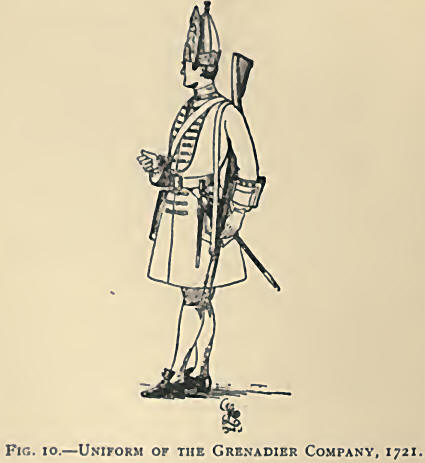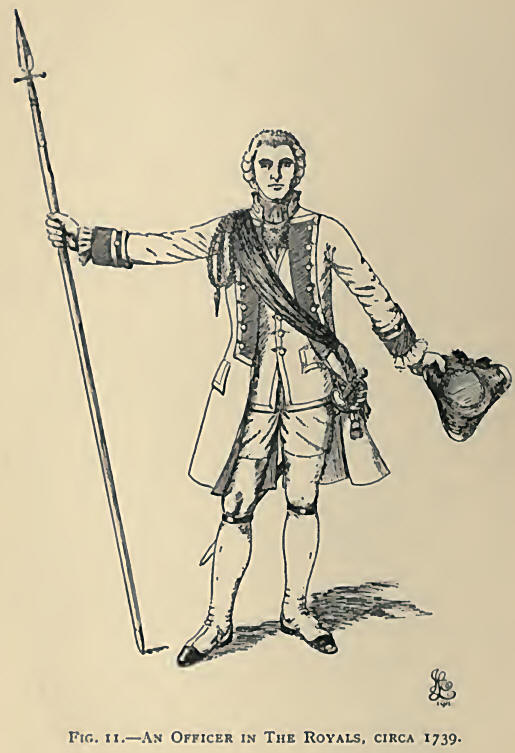|
Police Duty in Ireland—Irish Recruits—Sergeant MacLeod— Death
of Colonel the Earl of Orkney.
The close of the War of the Spanish Succession gave The Royal
Scots their first long period of repose since they were a regiment. In 1712
commissions (all of them brevets) were issued appointing Lieut.-Colonel
Charles Cockburn to be colonel, and Sir James Abercrombie, Bart., and Major
Alex. Irwin, lieut.-colonels, all to date from 1711. The Earl of Orkney had
been promoted full general on January 31, 1711. Charles Cockburn appears as
captain and brevet-lieut.-colonel in The Blenheim Bounty Roll, and was lieut
.-colonel in command of the second battalion at Malplaquet.
The regiment was described in an official list of April 23,
1713, as the “Royal Regiment of Foot, commanded by the Earl of Orkney,” and
took precedence there after three regiments of Guards.
In 1713 the regiment was reduced to peace strength but did
not return to England from Nieuport, near Dunkirk, until a fortnight after
the accession of George I. In the following year, it was moved to Ireland,
where large forces were kept to overawe the Roman Catholics, who favoured
the Old Pretender. From March 1715 and for many years it was on the Irish
establishment. The service in Ireland was of a demoralizing character and no
more than police work. The companies were split up into little units
occupying redoubts scattered over the disaffected districts “in places
infested by Torys, Rapparees, Robbers, and other wicked and evil disposed
persons."

The records of the next few years make very dull reading, for
they describe only changes of station, details of equipment, etc. In 1721 it
was ordered that all N.C.O.s and men should wear swords, which gives the
impression that, following on the introduction of the ring-socket bayonet,
the sword had fallen into disuse among the infantry. Fig. 10 shows a man of
the Grenadier company equipped with both. In 1722 the Irish Parliament added
a penny a day to the private soldier’s pay, making it sevenpence, because
there was so much leakage by desertion, the English rate being eightpence.
The Earl of Balcarres appears as a major in a paper of 1725,
and one of his men is found accusing Captain Innes of embezzling a barrel of
gunpowder, with what result it doth not appear.
There was a little excitement in 1727-1728, when war with
Spain appeared likely, and the establishment was increased. This brought
trouble, because, in defiance of explicit orders, Irishmen were enlisted.
Seven officers were found guilty of sending them to Scotland to be sworn and
then back to Ireland in Scotch bonnets, “that they might then the better
pass as North British recruits on the General Officer who reviewed them." It
is to be regretted that such ingenuity was rewarded by five of the officers
being “broken," and two suspended.
A good standard of height was kept, as is shown by a
regulation stipulating that Foot Guards should be 5 ft. 9 in., and the Foot
5 ft. 8 in.
It is characteristic of early records of the army that the
doings of “private men" and non-commissioned officers are rarely noted. As
Mr. Fortescue remarks: “We remain still without a picture of the typical
soldier of Marlborough.’’ During the long peace the state of the army was
unspeakably bad. It was recruited from men of the lowest class, often
criminals, and the indiscipline of the officers was reflected in the gross
behaviour and desertion of the men, punished with hideous severity. The
Civil Government feared and disliked the army, and the refusal to vote
proper sums for its upkeep led to every sort of corruption amongst officers,
to false pay sheets and to scandals without end. Rottenness in the
commissioned branch naturally led to infinite evils amongst the men, who
took the bad examples they saw, and followed them after their own fashion.
George I fought strenuously against all these abuses, and
took a vivid interest in securing a higher standard of efficiency. He
concerned himself with every detail, such as the substitution of steel
ramrods for wooden ones. Now and again an outstanding personality emerges,
and such was Sergeant Donald • MacLeod, a famous swordsman. In 1730 he
obtained his discharge from The Royal Scots for the purpose of joining, as
drill-sergeant, the independent companies in the Highlands which formed The
Black Watch. He started life as a stonemason, and finding this work
uncongenial enlisted in The Royals, at Perth. His promotion was rapid, for
he was a sergeant at seventeen. He was present at Schcllcnbcrg, Blenheim,
Ramillies and several minor affairs, and was at this time considered by his
comrades as champion swordsman in the regiment. He fought duels with a
French officer, a French sergeant, and a German officer, all of whom he
overcame. After the Peace of Utrecht, when quartered in Dublin, he fought a
duel with an Irish giant, named MacLean, wiio, when shaking hands before the
encounter, squeezed MacLeod’s hand so tightly that he roared with pain, and
vowed the Irishman should lose his right arm, which he did. During the
rising of 17I5,he fought Captain MacDonald, of Knoydart, from the Highland
army. MacDonald acknowledged himself as beaten when MacLeod skilfully
severed his sporran strap. MacLeod distinguished himself at Sheriffmuir, and
towards the close of the action was engaged with two Frenchmen, both of whom
he killed, being dangerously wounded himself.
[MacLeod must have got leave from the regiment for this
Scottish adventure, for The Royal Scots took no part in quelling the
’Fifteen. Lord George Murray, a son of the Duke of Atholl and nephew of Lord
Orkney, who joined The Royals as ensign in 1711 and fought with them in
Flanders, went over to the Jacobites and commanded a regiment of Athollmen
until the rising failed and he had to escape to France. The English
Government was wise not to employ The Royals on anti-Jacobite service in
Scotland, for many of them no doubt had Stewart sympathies. Sergeant
MacLeod’s career after he joined the Black Watch may be read in Mclnnes’ Brave
Sons of Skye, but is so notable that its outline may be indicated here. He
was at Fontenoy, where he distinguished himself and was again wounded. He
transferred to Fraser’s Highlanders, and served at Louisburg and Quebec, and
it was in his plaid that General Wolfe was carried off the field. He was
wounded in two places in this action, and had the honour of being appointed
one of the guard over General Wolfe’s body on the journey to Britain in
1759. He was admitted an out-pensioner of Chelsea Hospital in December 1759,
being then in his seventy-first year, the only official recognition of his
bravery and service. Having recovered from his wounds, he served in
Campbell’s Highlanders in Germany, where he was twice wounded. He remained
in the army till 1776 (he was then eighty-eight !), and then returned to the
Highlands to settle down. He was shipwrecked and lost his money and his
trusty sword, but notwithstanding all the hardships he had gone through
lived to be one hundred and three.]
The ninety years of fighting which The Royal Scots had seen
doubtless bred many another like MacLeod, but their doughty exploits have
found no memorial.
Nothing interesting happened until 1737, when the Earl of
Orkney died. A year before he had been created a Field-Marshal, a fit crown
to forty-five years of service in The Royals. In June, the King conferred
the colonelcy on the Hon. James St. Clair. He had been gazetted to The
Royals as an ensign in 1694, when he was six years old, but had exchanged
into the Third Guards as captain when he was sixteen. The regiment was now
known as St. Clair’s, and as The Royal Regiment of Foot.

As the next chapter returns to the narrative of war, we may
here anticipate a little and refer to an order of George II with regard to
uniform. He had brought German thoroughness to bear on all questions of
equipment, and in 1742 was published by Royal command “A Representation of
the Cloathing of His Majesty’s Household and all the Forces upon the
Establishment of Great Britain and Ireland," which had no doubt been some
time in preparation. It gives a coloured drawing of the uniform of every
regiment, and the picture which forms the frontispiece of this book has been
based on it.2 The facings are blue, as becomes a Royal regiment, but it is
not known when they were changed to blue from white. It certainly was not
effected when the title Royal was given, but had probably been made long
before 1742. Fig. 11 shows what a brave figure was presented by an officer
in The Royals. |

